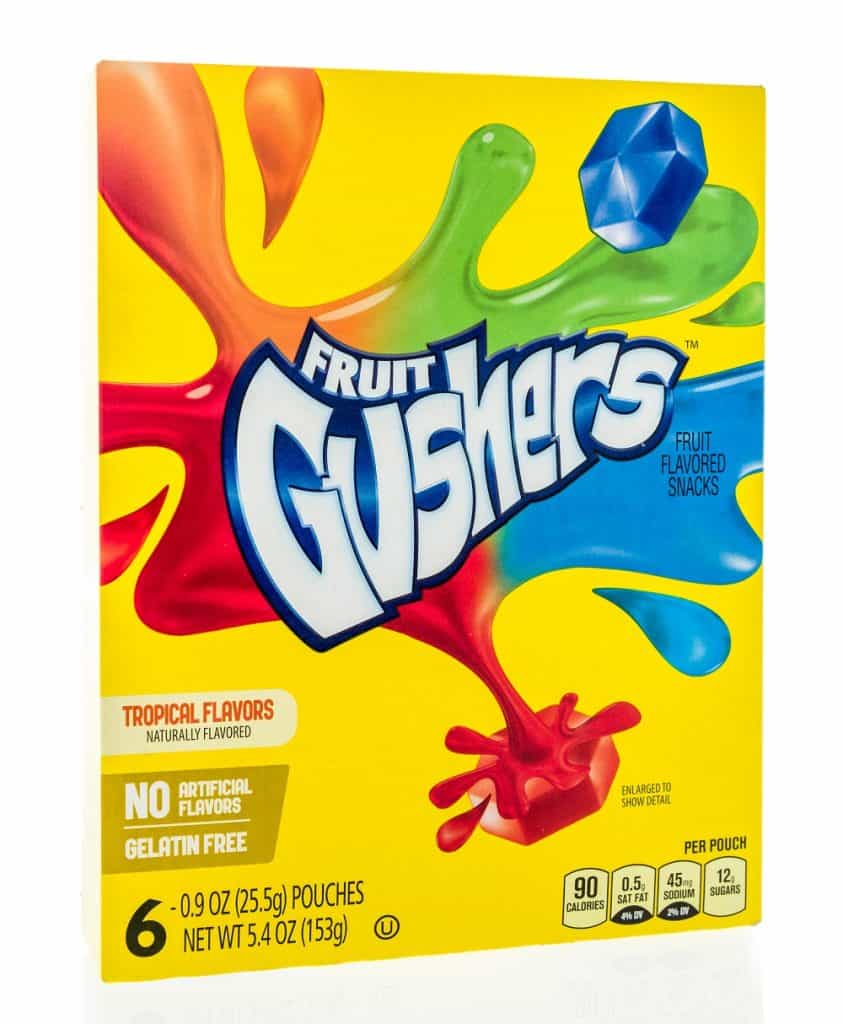Fruit Gushers, also known as Gushers, are a fruit candy snack that is typically known to come in a variety of colors and flavors. The name of the product refers to the nature of its design. While Fruit Gushers have a gummy exterior, a fruity juice can be found in the center that would “gush” out when an individual has reached it. First introduced in 1991 by Betty Crocker, the company that is also responsible for other popular fruit snacks such as Fruit by the Foot and Fruit Roll-Ups.
Fruit Gushers do not contain any obvious animal product or derivative which means that the food product is completely vegan. However, the fruit candy snack does contain some ingredients that some vegans do not feel comfortable with such as sugar, natural flavors, and artificial coloring agents.
Table of Contents
Are Fruit Gushers Vegan?

Since Fruit Gushers do not contain any obvious animal products or derivatives, the fruit candy snack can be considered to be perfectly vegan. There are no specific ingredients that make up this food product that is blatantly against veganism.
However, there are some ingredients that can cause concern. These so-called gray area ingredients are substances that some vegans are okay with while some vegans are not. These include sugar, natural flavors, and artificial coloring agents.
As a snack with a gummy texture, Fruit Gushers are actually more welcoming for vegans since it specifically uses carrageenan – a product sourced from seaweed. This is an important factor because similar gummy products use gelatin. While carrageenan is obtained from seaweed, gelatin is typically derived from animal collagen which makes products that contain gelatin more likely to be non-vegan.
Fruit Gushers Ingredients List
Fruit Gushers come in a variety of packs that often come with a mix of different flavors. These would include (1): Variety Pack (Strawberry Splash and Tropical Flavors), Super Sour (Crabby Apple, Grumpy Grape, and Scary Cherry), Flavor Mixers (Strawberry Peach, Orange Cherry, and Raspberry Lemonade), Mouth Mixers (Raspberry Lemonade, Strawberry Peach, and Orange Cherry), Tropical (Tropical Flavors), and Sweet and Fiery (Hot Mango, Fiery Peach, and Spicy Watermelon).
Each specific flavor of Fruit Gushers would have its own specific list of ingredients. For example, the Strawberry Splash contains these ingredients (2): sugar, corn syrup, dried corn syrup, pear puree concentrate, modified corn starch, fructose, maltodextrin, palm oil. Contains 2% or less of: cottonseed oil, glycerin grape juice concentrate, carrageenan, citric acid, monoglycerides, sodium citrate, malic acid, vitamin C (ascorbic acid), natural flavor, potassium citrate, agar-agar, red 40, xanthan gum.
However, the packs that contain a variety of flavors would have significantly more ingredients. For example, the Variety Pack includes (3): corn syrup, dried corn syrup, pear puree concentrate, modified corn starch, fructose, maltodextrin, palm oil. Contains 2% or less of cottonseed oil, glycerin, grape juice concentrate, carrageenan, citric acid, monoglycerides, sodium citrate, malic acid, vitamin c (ascorbic acid), natural flavor, potassium citrate, agar-agar, xanthan gum, color (red 40, blue 1, yellow 5 & 6). The ingredients listed above and the ingredients in Strawberry Splash can be found in the Variety Pack.
Sugar
As a sweet fruit snack, it comes to no surprise that Fruit Gushers contain sugar. A common sweetener used in the food and beverage industry, sugar is typically derived from plant sources such as sugarcane and sugar beets. However, despite its plant sources, sugar can be considered non-vegan depending on how it is produced.
To make sugar more appealing to consumers, many sugar companies subject their sugar to additional refinement processes. These additional refinement processes make sugar whiter and finer. Further refinement can include many different processes but the issue with sugar comes from one process in particular: filtration.
Different companies use different filtration methods and most of these methods are perfectly suitable for vegans. However, some sugar companies filter their sugar using bone char – the charred skeletal remains of various animals. Although bone char is a cheap and effective filter, it is an animal product. Thus, sugar that has been produced with bone char cannot be considered to be vegan.
Unfortunately, a problem with the use of bone char in the sugar industry is that it is difficult to determine if whether sugar has been processed this way or not. The problem is increased when large food companies obtain their sugar from multiple sugar companies. This makes it even more difficult to determine since the sugar companies where these large food companies get their sugar use different methods and make tracking even more difficult.
Sugar is considered to be a gray area ingredient since it is difficult to determine if whether it is truly vegan or not. However, vegans in other parts of the world are less concerned with this matter because the practice of using bone char is more prevalent in the US.
Natural Flavors
Natural flavors are a common ingredient that can be found in many food and beverage products. The FDA states that the purpose of natural flavors is primarily to impart flavor which means that the ingredient serves as a flavoring agent. Natural flavors can contain a wide array of constituents as long as they are sourced from nature as opposed to artificial flavors which are essentially synthesized. However, the issue with natural flavors is its vague definition. Specifically, the FDA defines natural flavors as (4):
“The essential oil, oleoresin, essence or extractive, protein hydrolysate, distillate, or any product of roasting, heating or enzymolysis, which contains the flavoring constituents derived from a spice, fruit or fruit juice, vegetable or vegetable juice, edible yeast, herb, bark, bud, root, leaf or similar plant material, meat, seafood, poultry, eggs, dairy products, or fermentation products thereof, whose significant function in food is flavoring rather than nutritional.”
FDA.gov
Looking at the definition above, it stands to reason that natural flavors must contain substances that are derived from organic sources. However, the umbrella definition includes both plant- and animal-derived sources which is why the ingredient is often considered a gray area ingredient because there is no way to determine if a product containing natural flavors is indeed vegan or not.
Food Coloring Agents
Color is an important part of the food and beverage experience which is why food manufacturers pay close attention to the colors of their products. Some food products come with naturally appealing colors due to their ingredients. However, some food products have to be actively manipulated to get their desired colors. This is primarily attributed to food coloring agents. There are many kinds of food coloring agents being used in the industry, but vegans are especially mindful of artificial coloring agents.
Artificial coloring agents are all synthesized and they usually require petroleum-based raw materials. To date, artificial coloring agents are unlikely to contain any animal product or derivative which means they are perfectly suitable for dietary vegans. However, the problem with artificial coloring agents is an ethical one.
Since these substances are synthetic, safety is ensured by various food safety authorities before they accept and approve the use of artificial coloring agents. While safety is indeed irrefutably important, there are certain ways for testing safety that go against the principles of ethical vegans – the use of animal models.
The use of animal models for safety testing is an old and outdated practice and has led to the deaths of innumerable animals. The practice of using animals is said to be especially unethical in today’s standards since there are other methods that could be effectively used to evaluate the safety of substances without the use of animals. These methods would include using cell models and in silico studies (i.e., the use of computer modeling and algorithms).
To give Fruit Gushers different colors, the fruit snack specifically uses several artificial coloring agents such as red 40, blue 1, yellow 5, and yellow 6. These artificial coloring agents have been heavily documented to be used on a variety of animals including mice, rats, guinea pigs, hamsters, pigs, rabbits, dogs, and cats (5, 6, 7, 8).
References
1. https://www.bettycrocker.com/
2. https://www.bettycrocker.com/
3. https://www.bettycrocker.com/




